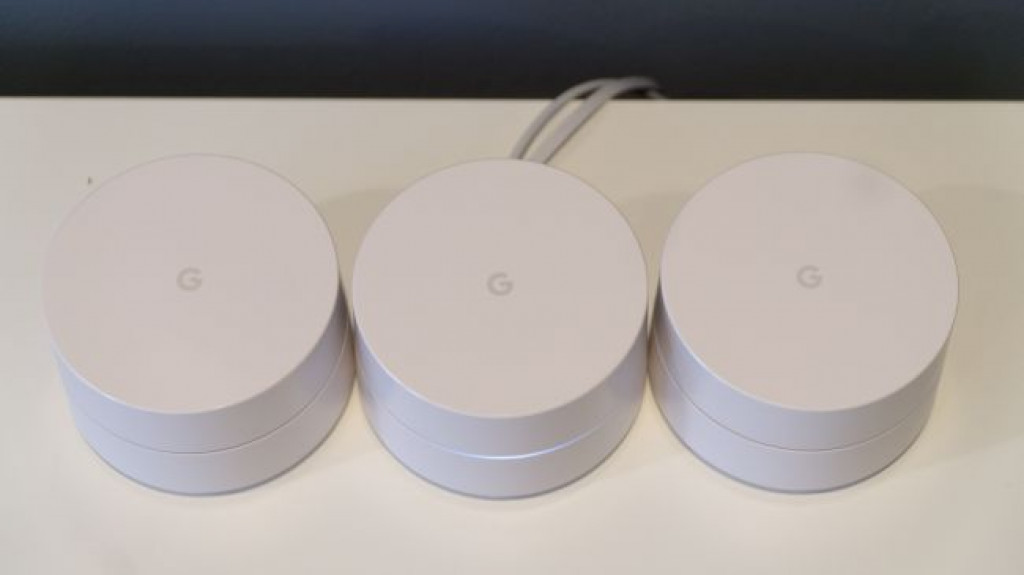
OUR VERDICT
Google Wi-Fi is the simplest and most convenient router that we’ve ever set up, hands down. It might not be the most powerful or offer specific controls, but it more than makes up for any lack of depth in its unparalleled simplicity.
FOR
- Super-simple setup
- Great value
- Excellent design
AGAINST
- Limited hardware control
- Lower AC rating
The age of the traditional wireless router is coming to an end, gradually getting replaced by wireless mesh routers like the Google Wi-Fi. Devices like the Netgear Orbi and Samsung Connect Home are exceptionally popular these days, so it shouldn’t come as a surprise that Google has jumped on the bandwagon with the Google Wi-Fi.
Google’s wireless router undertaking has definitely paid off. Not only is Google Wi-Fi the best wireless mesh router you can buy today, but it’s also one of the best routers in 2019. This is largely thanks to the fact that it packs in more mesh units at a lower price than rivaling mesh routers.
This attention to value is paired with an easy setup and excellent network management through a minimalist mobile app. Take our word for it – after using the Google Wi-Fi, you won’t want to use any other wireless router.
Price and availability
With what it has to offer accessibility- and features-wise, Google isn’t asking for a lot, especially for what the Google Wi-Fi can do. It will cost you $259 (about £204, AU$399) for a set of three units, comprised of one main ‘Wi-Fi point’ (the one you hook up to the modem or gateway) and two secondary Wi-Fi points. Google promises that three Wi-Fi Points can cover up to 4,500 square feet (418 square meters) in a home.
A single Google Wi-Fi unit can be had for only $99 (£129, AU$199), if you are working with a small apartment space. If you’re in the UK, you’ll also find the Google Wi-Fi in both a 2-pack and a 3-pack, which will set you back £229 and £329, respectively.
Australians will be ecstatic to know that the Google Wi-Fi is finally available – they can pick up a single node for AU$199 and the 3-pack for AU$499.
The Google Wi-Fi is a great value – it offers more units for less cash than any other rivals, like the Netgear Orbi, with other wireless mesh routers coming in at $400 (about £320, AU$520), at least, for the same amount of mesh nodes.

Design and setup
Google not only has an advantage in pricing on its hands, but it also has the sleekest designed Wi-Fi units and the most effortless setup of any offering. Each Google Wi-Fi unit, a small and simple cylinder with a white LED band in its center, delivers the same capability.
This means that any Google Wi-Fi unit can function as the core ‘router’ of the system, while the others can extend wired Internet, beamed to the unit wirelessly, with their included Ethernet ports as well as wireless internet. All three units are powered through USB-C.
Setup is also completely smooth, just like the Google Wi-Fi’s hardware design – utilizing a free iOS or Android app to facilitate the whole process. We’re not going to dive into the nitty gritty of the process, but the Google Wi-Fi App will let you configure your network by first scanning the QR codes on the Wi-Fi point connected to your modem or gateway.
The app will then ask you to give your new network a name and set a password, then pair any supplementary Wi-Fi points you have, by scanning their QR codes – you’ll then have the ability to name individual nodes in the app. Again, it only takes a moment for the first Google Wi-Fi node to recognize additional nodes and for them to start working.
You’re not going to get the same depth of access as even Netgear Orbi provides, so band switching isn’t an option. However, Google Wi-Fi does handle this in behind the scenes automatically.

The Google Wi-Fi app does offer more useful settings, like continuous monitoring of your network, as well as the points and devices connected to it. The app has a built-in internet speed test as well, like Ookla’s mesh test that measures the health of your Points’ connections, alongside a Wi-Fi test that measures your connection strength from within the network.
This is the most comprehensive and elegant suite of controls we’ve ever seen on a Wi-Fi mesh system so far, in spite of its lack of dropdown boxes and toggles.
Furthermore, you can prioritize bandwidth to one device for a time, control smart home devices and pause internet access to certain devices in a family setting – all from within this app.
And, now Google has expanded Google Wi-Fi’s Network Check feature to test multiple devices, so that you can spot possible bottlenecks in your network, as well as rearrange your Google Wi-Fi access points when you’re trying to optimize network performance.

Performance
The Google Wi-Fi is able to match, if not surpass, Netgear Orbi’s performance. Drawing the absolute most out of our 100Mbps Wi-Fi service, we’ve certainly not seen any router be able to deliver the same service. But, the core difference here is that Google Wi-Fi can bring this high performance in every room of our, albeit small, house.
We are able to stream 4K video through Netflix to our Roku Premiere in the basement, as well as playing Overwatch in the office where the modem is situated without issues. Wi-Fi mesh systems like the Google Wi-Fi aren’t focused so much on throughput as they are on coverage. However, this product certainly delivers.
The traffic prioritization feature ensures that your gaming session is getting more of that critical bandwidth than the other devices in your house that are used most frequently for Facebooking and streaming HD videos. In addition, the network can automatically repair itself should one or more of the Wi-Fi Points inadvertently lose power.
Even though we know that Google Wi-Fi operates its mesh system over existing Wi-Fi bands (2.4GHz and 5GHz) over the 802.11s mesh protocol rather than Netgear Orbi’s tri-band system that communicates over a second 5GHz Wi-Fi band, we haven’t seen a sizeable difference between either’s performance. We do see marginally faster download speeds in MB/s on the 2.4GHz band from the Orbi over the Google Wi-Fi. However, that could also be a possible anomaly.

Where the Google Wi-Fi really excels over similar routers is in its impressive price to coverage ratio. You can get identical coverage from rivaling systems with fewer units, sure, but the versatility of having more units gives you – just in terms of minimizing dead spots – is massive.
Final verdict
The Google Wi-Fi is the simplest and most effortless router we’ve ever set up, bar none. And, that’s taking into account the two extra devices required to finish the process. For a reasonably low price point, there are more units on offer than most of Google’s rivals, as well as the best setup and management app so far.
Despite the finer hardware controls it lacks, and the lack of AC3000 or AC2200 throughput, Google deliberated every toggle and test it could present in an easily understandable way through its app. There’s even bandwidth priority control. Pair that with a clean, uncluttered hardware design that’s better to showcase in plain view than any other routers we’ve seen yet, and what you have is one of the best Wi-Fi systems that money can buy in 2019.
Source: techradar.com









































